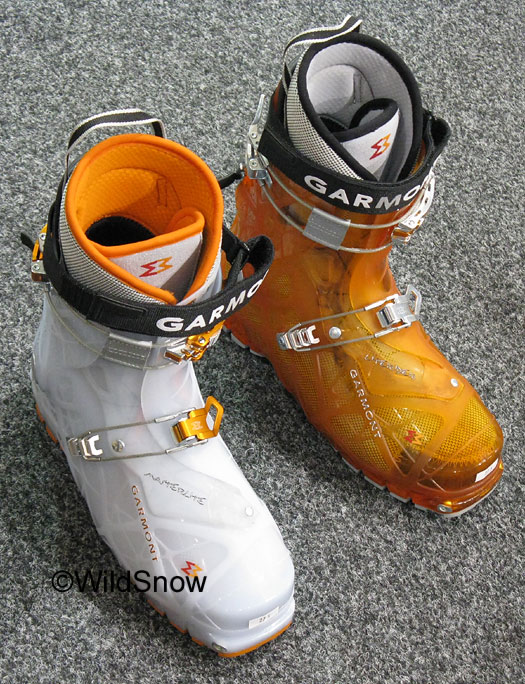Shop for Garmont ski boots here.
I’m a bit wasted with jet lag and have a bunch of fun EU trip reports to file, but I’m here at the OR show so a bit of the ol’ gear talk has to happen. So here’s a smidge before the land of nod becomes home, with more tomorrow from the temple of toys.
A few years ago, you didn’t have to be the Great Karnak to predict that big heavy AT boots would enjoy a brief burst of PR fueled buzz, then, for a lot of people, become nothing more than a good way of burning more calories.
After all, massive AT boots have actually been around for years, and with a bit of work could be made to ski quite well. More, during those same years, boots that saved weight never lost their appeal. In fact, worldwide, most backcountry skiers use shoes on the minimalist side of the equation.
So it didn’t surprise me to see Dynafit’s sleek new TLT-5 a week ago, nor Black Diamond’s debutant Efficient series boots just before that. And when briefly stopping by Scarpa’s booth today, something interesting caught my eye that’ll be worthy of another boot blog tomorrow.
Likewise, I had to suppress a smug knowing smile when I stopped by the Garmont booth today and feasted my eyes on the trim figures of their entirely new and beautifully designed Masterlite and Literider two-buckle overlap cuff backcountry skiing boots.

Garmont Masterlite (left) and Literider
Masterlite is constructed with Pebax plastic and weighs in at 1090 grams (size 27), with Literider looking to be nearly the same design, only built with PU plastic, slightly stiffer, and 100 grams more. If the production versions of these guys come out with those numbers, that means the Masterlite could beat other lightweight boot makers at their own game, or at least tie the score.
These are of course not metatarsal bending boots such as Scarpa F1 or Dynafit TLT. Nonetheless, Masterlite is designed to flex a tiny bit in the forefoot. I’m fine wth that, as I’ve never been convinced that a metatarsal bending ski boot does much beyond a psychological boost, and perhaps adds comfort to standing around in the parking lot having a beer. (If you’re a rando racer or ski tourer using glidey skins on low angled terrain, different story.)
Garmont’s weight savings is accomplished a number of ways: Low volume shell, super minimal sole, no liner lacing, three small buckles, minimal lean lock. Speaking of which, the lean lock only locks the cuff from rearward motion, with shell design limiting forward flex after a certain point. The idea with this (used in many AT boots over the years) is that not rigidly locking forward cuff movement results in a sweeter alpine mode flex. Of course the danger with that in a minimal boot is that the cuff will collapse forward. But the fairly rigid fold of the overlap cuff in front of your shin may be enough to prevent that.
Other features of the new Garmonts include the tech fitting in the toe mounted 5 mm back for better ergonomics, extra rocker in the sole and a non DIN standard toe shape (won’t work in a Fritschi or other frame binding, only in a Dynafit compatible binding). The liners are nice, with a hinge for rearward ease of movement.
The lower volume of this boot category does result in a thinner liner, which in turn may mean it’s harder to fit such shoes for warmth without upsizing and possibly adding an aftermarket liner. Keep that in mind if you’re getting all starry eyed about shopping. Indeed, the best combo of warmth and light weight will probably continue being the more generously lasted boots in what will now be the “mid weight” category; shoes such as Garmont’s replacement for their Helium model, now called the Helix.
Yep, reality is that backcountry skiing is all about the down — and the up. So the lightweight boot category lives! As to how all these new offerings perform in real life, that remains to be tested by the WildSnow crew over the coming months.
For now, ah, what was I writing about?…my eyes…are……..shut.
Shop for Garmont ski boots here.
WildSnow.com publisher emeritus and founder Lou (Louis Dawson) has a 50+ years career in climbing, backcountry skiing and ski mountaineering. He was the first person in history to ski down all 54 Colorado 14,000-foot peaks, has authored numerous books about about backcountry skiing, and has skied from the summit of Denali in Alaska, North America’s highest mountain.
